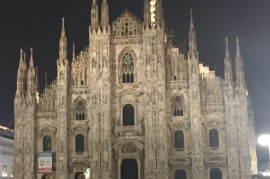Located on the Caribbean coastline and home to a population of 1.1 million, Barranquilla is Colombia’s fourth largest city. However, aside from hosting the world’s 2nd largest Carnaval – a 4-day celebration in which the city comes together to parade and party in the street – Barranquilla is mostly a commercial city.
In the absence of touristy attractions, I’ve had to adjust to the typical day-to-day life of a student in Barranquilla. Though the culture is quite different here, spending time with my host family, playing soccer at night, and trying to learn salsa (unsuccessfully) have made the transition quite enjoyable. And although Barranquilla itself isn’t a touristy destination, it is only an hour away from two of Colombia’s most popular cities, Cartagena and Santa Marta. In my first couple months, I’ve had the opportunity to travel to both.
 Cartagena is another city located on Colombia’s coastline. There are two main parts to the city, the old town, which has many fancy hotels, restaurants and clubs that are enclosed by colonial walls. And the second part, Bocagrande, which is a long strip of condos and hotels that overlook the beach. Bocagrande is a residential area, with parks and places to jog, while the old city is more touristy, filled with street vendors and indigenous dance performances.
Cartagena is another city located on Colombia’s coastline. There are two main parts to the city, the old town, which has many fancy hotels, restaurants and clubs that are enclosed by colonial walls. And the second part, Bocagrande, which is a long strip of condos and hotels that overlook the beach. Bocagrande is a residential area, with parks and places to jog, while the old city is more touristy, filled with street vendors and indigenous dance performances.
Though the beaches in Cartagena are great, the most beautiful, picturesque ones are on islands off the coast. In order to reach the Rosario Islands, an archipelago with a coral reef, we had to take a two hour ferry ride on the open ocean. Though the ride was long and relatively bumpy, the turquoise water, white sand beach, and salty breeze were well worth the trip. We spent the day on the island, relaxing, snorkeling, and taking a guided canoe tour around the island.
The city of Santa Marta itself isn’t particularly special, but its unique location next to Tayrona National Park and the Sierra Nevada Mountains, the world’s highest coastal mountain range, makes it a very popular destination for backpackers. On our first day in Santa Marta, we spent the morning hiking through the dense and humid jungle of Tayrona.
The intersection of the jungle, the ocean, and mountains, make for some very breathtaking scenery. During the hike, we were lucky to see some kapibaras, cool lizards, and a family of howler monkeys. After spending the afternoon on the beach, we rode horses back to the campsite before crashing in hammocks for the night.
Guest Blogger: Emory Witt is an Olin junior studying abroad in Colombia. He is studying Economics & Strategy, Finance, and Spanish.







 First, traveling to Amsterdam and the surrounding countryside exposed me to the Dutch influence in Maastricht. From the countless amount of bicycles being ridden around the city to the architecture, Amsterdam’s culture is truly prevalent in Maastricht. The reflection of culture is shown in the Dutch people who have incredibly unique personalities which are hard to describe in a few words but include: intelligent (many speak 3-4 languages), blunt (their efficient habits seem to carry over to their vocabulary), and fun-loving (Maastricht holds a weeklong Carnaval celebration in which people of all ages parade through the streets in Halloween-esque costumes).
First, traveling to Amsterdam and the surrounding countryside exposed me to the Dutch influence in Maastricht. From the countless amount of bicycles being ridden around the city to the architecture, Amsterdam’s culture is truly prevalent in Maastricht. The reflection of culture is shown in the Dutch people who have incredibly unique personalities which are hard to describe in a few words but include: intelligent (many speak 3-4 languages), blunt (their efficient habits seem to carry over to their vocabulary), and fun-loving (Maastricht holds a weeklong Carnaval celebration in which people of all ages parade through the streets in Halloween-esque costumes). Secondly, my trip to Paris showed me the French influence on the city of Maastricht which can be described in one word, food! To many students’ delight, the traditional bakeries and cafes of Paris can also be found on the streets of Maastricht serving pastries and baguettes.
Secondly, my trip to Paris showed me the French influence on the city of Maastricht which can be described in one word, food! To many students’ delight, the traditional bakeries and cafes of Paris can also be found on the streets of Maastricht serving pastries and baguettes.



 Cartagena is another city located on Colombia’s coastline. There are two main parts to the city, the old town, which has many fancy hotels, restaurants and clubs that are enclosed by colonial walls. And the second part, Bocagrande, which is a long strip of condos and hotels that overlook the beach. Bocagrande is a residential area, with parks and places to jog, while the old city is more touristy, filled with street vendors and indigenous dance performances.
Cartagena is another city located on Colombia’s coastline. There are two main parts to the city, the old town, which has many fancy hotels, restaurants and clubs that are enclosed by colonial walls. And the second part, Bocagrande, which is a long strip of condos and hotels that overlook the beach. Bocagrande is a residential area, with parks and places to jog, while the old city is more touristy, filled with street vendors and indigenous dance performances.
